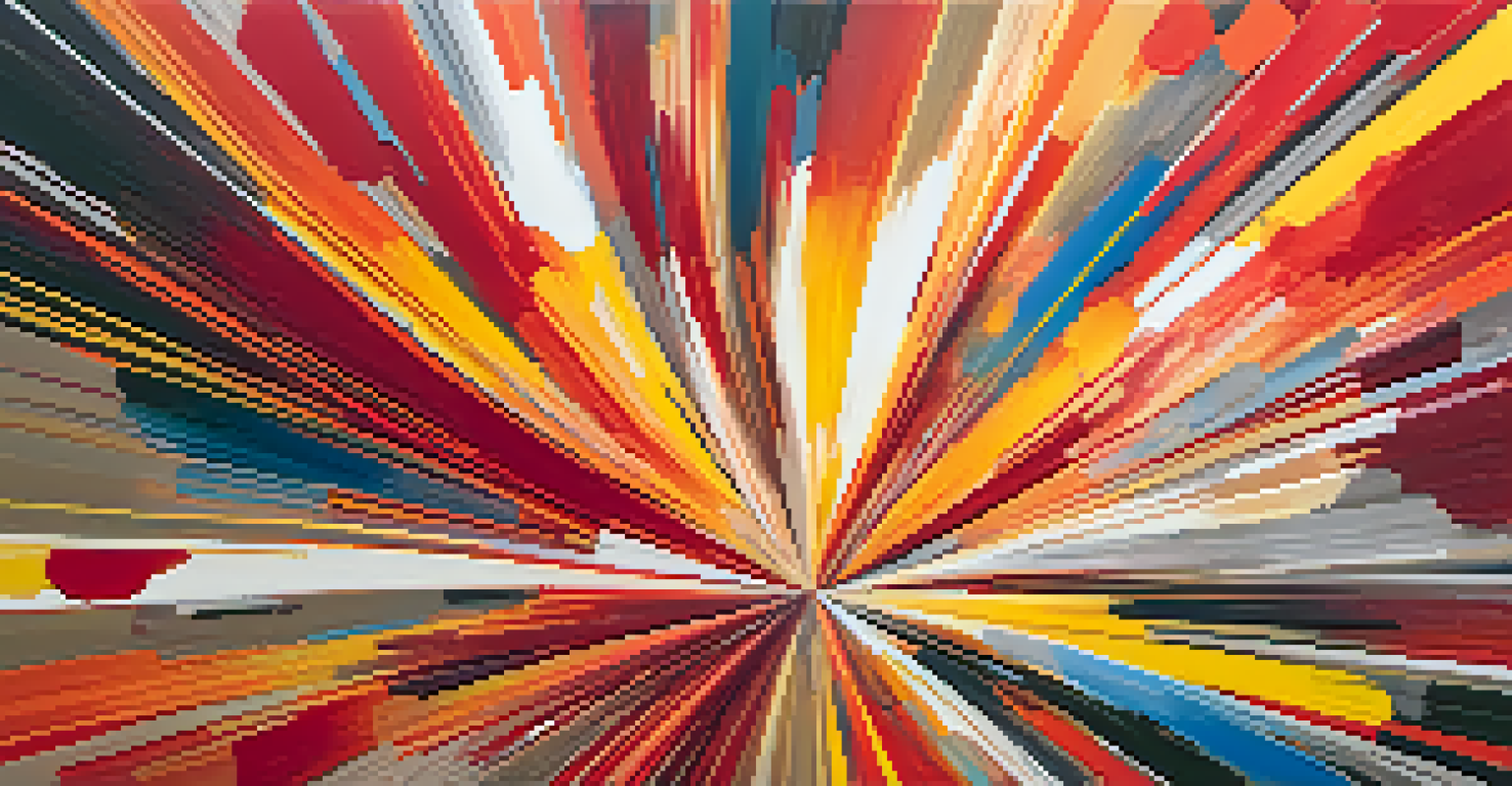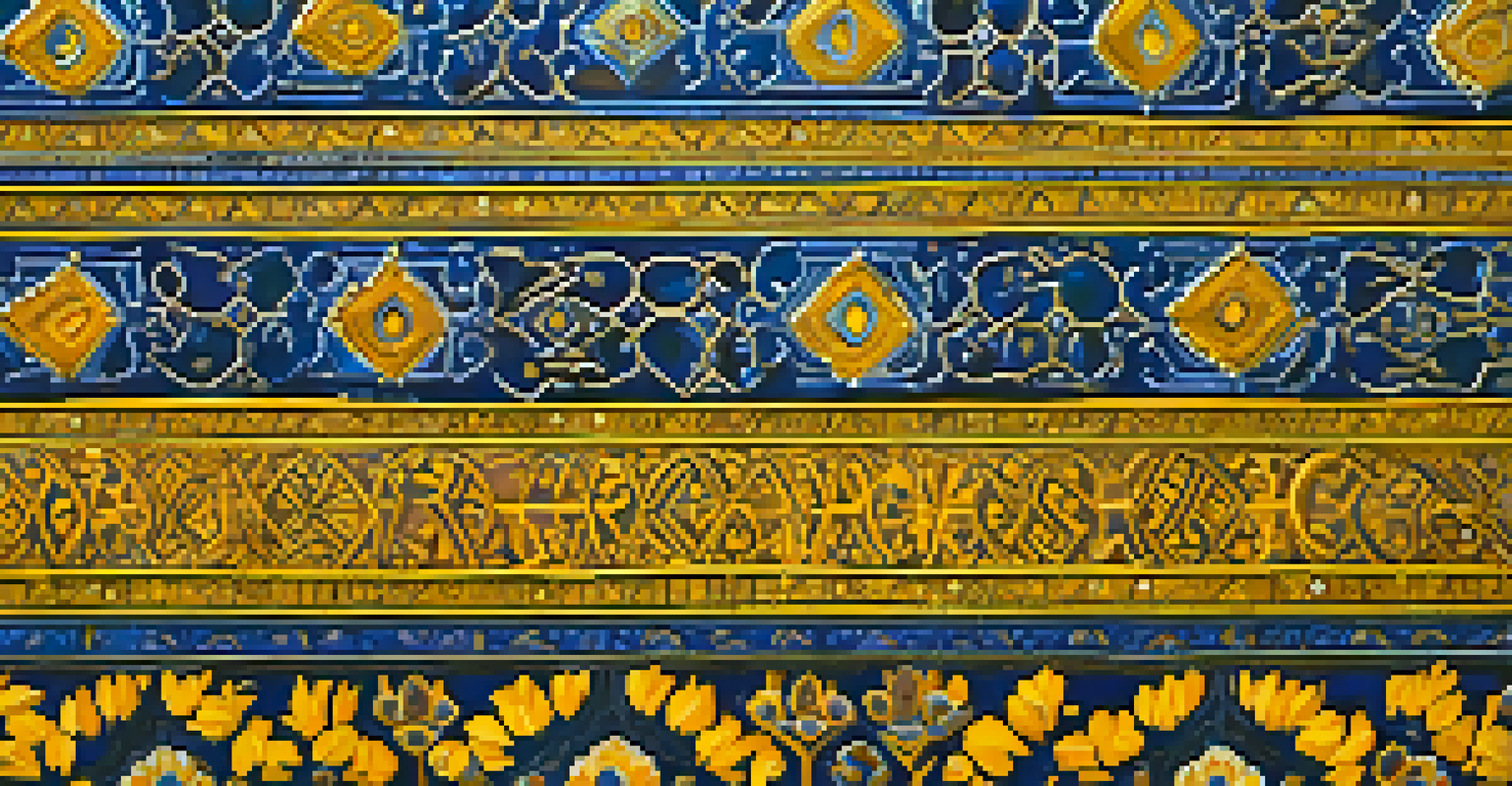The Use of Color in Eastern and Western Art Forms

Understanding the Basics of Color Theory in Art
Color theory is the foundation of how artists use color to convey emotions and messages. In both Eastern and Western art, color plays a crucial role in creating mood and atmosphere. For example, warm colors like red and orange often evoke feelings of passion, while cool colors like blue and green can induce calmness.
Color is the keyboard, the eyes are the harmonies, the soul is the piano with many strings.
In Western art, color theory often revolves around the color wheel, developed by Isaac Newton, which illustrates the relationships between primary, secondary, and tertiary colors. Artists utilize complementary colors to create contrast and visual interest, enhancing the viewer's experience. This systematic approach helps Western artists to create dynamic compositions.
Conversely, Eastern art often integrates color in a more symbolic and philosophical way. For instance, in traditional Chinese art, colors are frequently associated with elements of nature and emotions, such as red representing happiness and good fortune. This cultural significance adds layers of meaning to the artwork, making color an integral part of storytelling.
Symbolism of Colors in Eastern Art
In Eastern art, colors are rich with symbolism and cultural significance. For example, white is often associated with mourning and purity, while red symbolizes joy and celebration. This deep-rooted connection between color and meaning allows artists to convey complex narratives through their work.

Take the vibrant use of color in traditional Indian art, where each hue has a specific significance. Yellow might represent knowledge and learning, while blue is often linked to divine nature. This thoughtful approach to color transforms the viewer's experience, inviting them to explore the deeper meanings behind each shade.
Color's Emotional Power in Art
Color is a powerful tool that artists use to evoke emotions and convey messages across different cultures.
Moreover, in Japanese art, the concept of 'wabi-sabi' embraces the beauty of imperfection and transience. Colors like muted greens and browns are commonly used to reflect the natural world, highlighting simplicity and harmony. This philosophy showcases how color can be a reflection of cultural values and beliefs.
Color in Western Art: From Renaissance to Modernism
The use of color in Western art has evolved dramatically from the Renaissance to modern times. During the Renaissance, artists like Leonardo da Vinci utilized a technique called 'chiaroscuro,' which employs strong contrasts between light and dark to create depth and volume. This mastery of color brought a new level of realism to paintings.
Colors, like features, follow the changes of the emotions.
As we moved into the Baroque period, color became even more dramatic, with artists like Caravaggio using bold colors to evoke emotion and draw the viewer's eye. This period emphasized the psychological impact of color, where it was used to enhance narratives and capture human experiences.
In the 20th century, movements like Impressionism and Expressionism further expanded the boundaries of color use. Artists like Claude Monet and Vincent van Gogh experimented with vibrant palettes to convey feelings and impressions rather than realistic depictions. This shift marked a significant departure from traditional approaches, showcasing the power of color as a form of expression.
Cultural Influences on Color Perception
Culture plays a significant role in how we perceive and interpret color. In Western societies, colors are often associated with specific meanings, such as black symbolizing mourning and white representing purity. These associations can shape our emotional responses to art and influence how we engage with it.
In contrast, Eastern cultures may have entirely different interpretations of the same colors. For instance, while white is seen as a color of mourning in many Western contexts, it is often associated with purity and new beginnings in Asian cultures. This divergence highlights the importance of cultural context in understanding color use in art.
Cultural Significance of Colors
Colors carry distinct meanings in Eastern and Western art, shaping how artwork is interpreted and experienced.
This cultural lens not only influences individual artists but also shapes broader artistic movements. As globalization continues to intertwine different cultures, artists are increasingly blending these diverse color perspectives, creating a rich tapestry of artistic expression that resonates with a global audience.
The Psychological Impact of Color in Art
Color psychology explores how colors affect human emotions and behaviors, making it a powerful tool for artists. In both Eastern and Western art, certain colors can evoke specific feelings. For example, blue often promotes tranquility and calmness, while red can elicit excitement or aggression.
Artists are keenly aware of these psychological effects and choose their color palettes accordingly. For instance, a serene landscape painted in soft blues and greens can transport viewers to a peaceful state, while a vibrant, chaotic abstract piece with bold reds and yellows may provoke feelings of energy and urgency.
Understanding this psychological aspect not only enriches the viewing experience but also enhances the artist's ability to communicate their intended message. By tapping into the emotional power of color, artists can create profound connections with their audience, making their work more impactful.
Modern Interpretations of Color in Art
In today's art world, the interpretation of color has become more fluid and experimental. Artists are not bound by traditional color theories or cultural meanings; instead, they explore personal expressions and innovative techniques. This evolution has led to a more inclusive understanding of color in art.
For example, contemporary artists like Yayoi Kusama use bold and repetitive colors to convey concepts of infinity and self-identity. Her work challenges viewers to engage with color on a personal level, blurring the lines between individual perception and collective experience.
Modern Color Exploration in Art
Contemporary artists are redefining color use, embracing personal expression and innovative techniques in their work.
Moreover, the digital age has opened up new avenues for color exploration. Digital artists can manipulate color in ways that were previously unimaginable, creating immersive experiences that captivate audiences. This ongoing innovation ensures that the conversation about color in art remains vibrant and ever-evolving.
Conclusion: The Universal Language of Color in Art
Ultimately, color serves as a universal language that transcends cultural boundaries. Whether in Eastern or Western art, color has the power to communicate emotions, tell stories, and evoke memories. This shared understanding of color allows artists to connect with audiences on a deeper level.
As we explore the diverse uses of color across different artistic traditions, we gain insights into the values and beliefs of various cultures. This journey not only enriches our appreciation of art but also fosters empathy and understanding between diverse communities.

In a world where art continues to evolve, the role of color remains as vital as ever. It invites us to embrace creativity, explore our emotions, and celebrate the beauty of diversity in artistic expression.